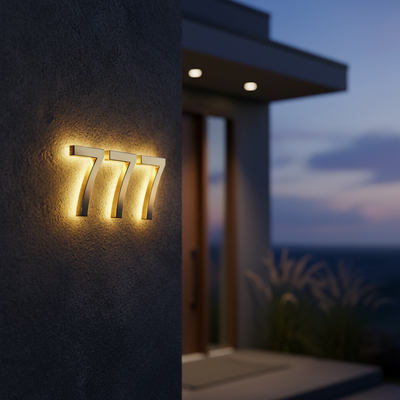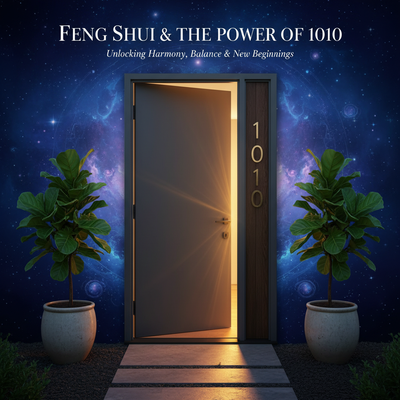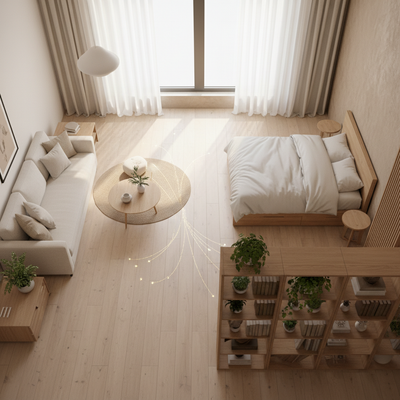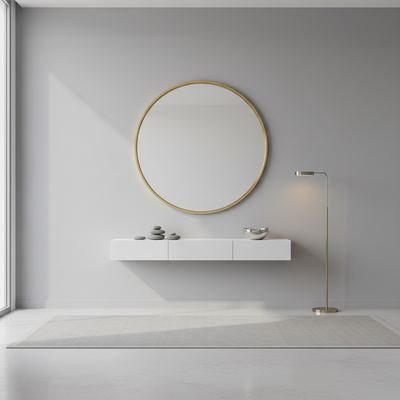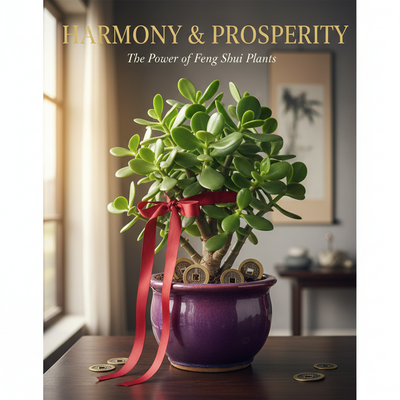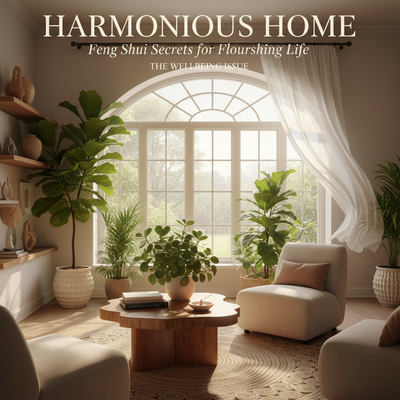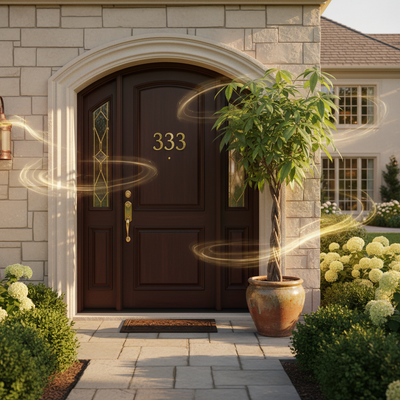What is the energy center of your home? In feng shui, this is an important question. The center of your house is its heart, a space that affects the health, stability, and overall harmony of everyone living there. Get the energy right here, and it spreads positive vibes to all other areas of your life. Get it wrong, and you might feel constantly stuck or unsteady.
The secret to balancing this important area is understanding its main element and using the right colors. The simple answer is that the feng shui center of the house connects to the Earth element. So, the best colors are earthy, grounding tones that create stability and comfort.
This guide will give you everything you need to master this important part of your home's energy. We will explore why the center matters so much, look at the Five Elements theory that guides our color choices, and give you a detailed list of the best and worst colors. To make these ideas real, we'll share a true story from our work at THE QI FLOW. Finally, we'll give you a practical, step-by-step guide to transform your own space.
The Heart of Your Home
In feng shui, the center of your home is called the Tai Chi. It is the energy core, the central point that feeds and balances all other life areas, or "guas" on the Bagua map. Think of it as the center of a bicycle wheel; if the center is weak or off-balance, the entire wheel becomes shaky and doesn't work well. Similarly, if the Tai Chi of your home has problems, the energy flow to areas controlling wealth, relationships, and career can be hurt.
This central area connects most directly to the physical health and overall well-being of every person in the home. It works as an anchor, grounding the property and the people who live there. A strong, balanced Tai Chi creates a sense of unity and connection, making it the foundation for a peaceful family life. It doesn't need to be a large, fancy room; it can be part of a hallway, an open living space, or even a stairwell. No matter what it looks like physically, its energy function is most important.
The main jobs of the Tai Chi include:
- Grounding and stabilizing the entire home's energy, or Qi.
- Directly affecting the physical and emotional health of all residents.
- Creating a sense of unity and connection within the family or household.
- Sending balancing energy outward to all other Bagua areas.
The Governing Element
To understand why certain colors work best, we must first look at the Five Elements theory, or Wu Xing. This ancient Chinese philosophy is a cornerstone of feng shui and describes how all energy interacts. The Five Elements are Wood, Fire, Earth, Metal, and Water. Each element connects with specific energies, qualities, shapes, and, most importantly for us, colors.
These elements exist in constant change, interacting through two main cycles: the productive cycle and the destructive cycle. In the productive cycle, one element creates or feeds the next: Wood fuels Fire, Fire creates Earth (ash), Earth produces Metal, Metal carries Water, and Water nourishes Wood. This cycle represents harmony and support.
In feng shui, the center of the Bagua map is clearly governed by the Earth element. This is the basic logic behind all recommendations for this area. The Earth element represents qualities of stability, nourishment, grounding, patience, and support. It is the energy of the mother, providing a secure base from which all things can grow. When your home's center is rich with Earth energy, it creates a feeling of safety, reliability, and strong health. Understanding this element connection raises your practice from simply following rules to making intentional, powerful changes.
Best Feng Shui Colors
Choosing the right color for your home's center is one of the most effective ways to boost its Earth energy. The goal is to create a space that feels supportive, calm, and stable. The best choices are colors that either directly represent the Earth element or colors from the element that feeds it in the productive cycle—Fire.
Primary Choices: Earth Tones
These colors are the most direct and powerful way to strengthen the Tai Chi. They are perfect for main wall colors or large furniture pieces.
-
Soft Yellows: Think of the gentle light of the sun warming the earth. Colors like pale yellow, saffron, and light ochre connect to warmth, cheerfulness, and optimism. In the Five Elements, yellow is a primary Earth color. It feeds the center, promoting good health and a positive outlook.
-
Beiges and Sandy Tones: These are the ultimate Earth colors. Shades like taupe, sand, khaki, and ecru are the most direct representation of soil and land. They have an immediate stabilizing and calming effect on a space, creating a sense of reliability and ease. They are perfect for creating a neutral, supportive background.
-
Earthy Browns: Deeper tones like terracotta, clay, and light chocolate brown bring a strong sense of grounding and security. These colors connect us to the stability of the earth beneath our feet and the strength of nature. They are excellent for adding a feeling of depth and support.
Accent Choices: Fire Tones
According to the productive cycle, Fire creates Earth. This means that Fire element colors can be used as powerful accents to energize and strengthen the center. However, it's important to use them sparingly. Too much Fire can create an overwhelming or restless energy. Use them for cushions, artwork, a vase, or a throw blanket.
- Muted Reds, Oranges, and Deep Pinks: A touch of these colors can add vitality, passion, and joyful energy. Think of a rich terracotta pot, a burnt orange cushion, or a piece of art with deep rose tones. These accents act like a vitamin boost, activating the Earth element and preventing stagnation without causing instability.
For maximum clarity, here is a breakdown of the best colors and their uses.
| Color | Symbolism & Energy | Best Use |
|---|---|---|
| Soft Yellow | Warmth, Optimism, Nourishment | Main Wall, Accents |
| Beige / Sandy Tones | Stability, Grounding, Calmness | Main Wall |
| Earthy Brown | Support, Security, Connection to Nature | Accents, Furniture |
| Muted Red / Orange | Vitality, Energy, Passion (Nourishes Earth) | Small Accents Only |
| Deep Pink / Rose | Gentle Warmth, Joy (Nourishes Earth) | Small Accents Only |
Colors to Avoid
Just as important as knowing which colors to use is knowing which ones to avoid. Using colors from the wrong element group can disrupt the harmony of your home's center, either by clashing with or draining its essential Earth energy. This is where understanding the destructive cycle of the Five Elements becomes a protective tool.
The Wood Element Clash
In the destructive cycle, Wood depletes Earth. Imagine a tree's roots breaking up the soil; the Wood element takes its nourishment from the Earth, weakening it in the process. Therefore, introducing a large amount of the Wood element's colors into your home's center is a significant feng shui mistake.
- Avoid large areas of green and bright blue. While these colors can be beautiful and calming in other areas of the home (like the east for family or southeast for wealth), they are harmful in the center. A green wall or a large green rug in the Tai Chi can symbolically drain the health-supporting and stabilizing energy, potentially leading to instability or health issues.
The Metal Element Drain
The relationship between Earth and Metal is part of the productive cycle: Earth produces Metal. While this is not a direct clash, it represents a one-way flow of energy. If you use too many Metal element colors in the center, the Earth element will be constantly exhausted as its energy is used to "create" Metal. It's like a parent who is always giving to a child without being replenished.
- Avoid large areas of white, gray, and metallics. Stark white and cool gray walls are a very common design choice, but in the center of a home, they can create a sterile, draining environment. They weaken the supportive Earth energy, which can show up as a lack of nourishment and support in the lives of the occupants. If you must use these colors, do so in very small doses and make sure they are balanced with a strong presence of Earth tones.
A Real-World Transformation
Theoretical knowledge is valuable, but seeing it in action provides true understanding. At THE QI FLOW, we frequently work with clients who feel a sense of disharmony in their homes, and often, the root of the problem lies in an imbalanced Tai Chi.
The Client's Challenge
We were contacted by the Chen family, who described feeling 'stuck' and disconnected from one another. They had two young children, and despite their efforts, the home felt chaotic and the family members felt like they were living separate lives under one roof. There was a low-grade, persistent feeling of being unsupported and a general lack of forward momentum in their personal and professional lives.
Our Feng Shui Analysis
Upon reviewing their floor plan and photos, our team immediately identified the issue. Their home was a modern open-plan design where the center was a small but crucial pass-through area connecting the kitchen, living room, and main hallway. This central zone was painted a stark, clinical white. Furthermore, it had become a dumping ground for clutter—shoes, backpacks, and mail accumulated on the floor, creating stagnant energy.
Our analysis showed a classic case of an exhausted Earth element. The overwhelming Metal element color (white) was constantly draining the home's central Earth energy. This energy drain was showing up in the family's life precisely as they described: a lack of family unity (the core's function) and a feeling of being unsupported and stagnant. The physical clutter was making the problem worse, blocking the flow of Qi entirely.
The Solution
We recommended a simple yet powerful two-part solution that required minimal investment but had a maximum energy impact.
First, we advised them to repaint the main wall in this central zone. They chose a warm, sandy beige from the palette we provided. This single act was designed to strongly re-introduce the governing Earth element, immediately shifting the space from sterile and draining to warm and supportive.
Second, to address the clutter and further anchor the Earth energy, we suggested adding a square, rustic wooden console table against the newly painted wall. The square shape is an Earth element shape. On the table, we had them place a beautiful ceramic bowl—another Earth element item—to serve as a designated 'drop zone' for keys and mail. This transformed the clutter from a chaotic pile on the floor into an intentional, organized feature.
The Result
The transformation was swift and profound. Within a few weeks of making these changes, Mrs. Chen contacted us, full of excitement. She reported that the entire home felt warmer, calmer, and more welcoming. The feeling of chaos had subsided. Most importantly, she noticed the family was naturally spending more quality time together in the adjacent living area. The feeling of stagnation was replaced by a sense of gentle forward momentum. The simple act of harmonizing the color and function of their home's heart had restored the feeling of connection and stability they had been missing.
Harmonizing Your Center in 5 Steps
Ready to apply these principles to your own home? This practical guide will walk you through the process, empowering you to make confident and effective changes. Follow these steps to diagnose and harmonize your home's energy heart.
1. Locate Your Home's Center
The first step is to accurately identify the Tai Chi. Get a copy of your home's floor plan (for each level). Draw two diagonal lines from corner to corner, creating a large 'X' across the entire layout. The point where the two lines intersect is the center of your home. It might land in a room, a hallway, or an open area. This is the space you need to focus on.
2. Assess the Current State
Now, go to that central spot and observe it with fresh eyes. What is the dominant color on the walls? Is it a supportive Earth tone or a draining Metal or Wood color? Look at the objects present. Is the area cluttered and chaotic, or is it open and calm? How does the space feel to you? Does it feel supportive and stable, or does it feel sterile, busy, or neglected? Be honest in your assessment. This provides the baseline for your transformation.
3. Choose Your Harmonizing Palette
Refer back to the "Best Feng Shui Colors" table in this guide. Based on your personal preferences and existing decor, choose a primary harmonizing color. This will likely be a soft yellow, a sandy beige, or a warm taupe for a main wall. Then, consider if you'd like to add a small accent from the Fire element, like a terracotta pot or a cushion with some muted red, to add a touch of vitality.
4. Test Before You Commit
Never commit to a paint color straight from a tiny chip. Paint is an investment of time and money, and light can dramatically alter a color's appearance. Get paint swatches or small sample pots of your top two or three choices. Paint large squares (at least 2x2 feet) on the wall in the center. Observe them at different times of day—in the bright morning light, in the afternoon, and with artificial light in the evening. Choose the one that consistently feels the most calming and supportive.
5. Apply with Intention
Once you've chosen your color, approach the act of painting and decorating with mindfulness. Don't see it as a chore. See it as a powerful, intentional act of care for your home and family. As you apply the paint or place your new decor, hold the intention of infusing the space with energy for health, stability, and unity. This mindful approach amplifies the positive effects of your feng shui adjustments, turning a simple design update into a meaningful ritual.
Cultivating a Stable Heart
Your home is more than just a structure; it's a living, breathing energy system that profoundly impacts your life. At its very core is the Tai Chi, the center that governs your health, stability, and the unity of your household. By understanding its foundational role, you gain the power to create a truly supportive environment.
The core message is simple and powerful: the center of the home belongs to the Earth element. The key to unlocking its potential is to decorate it with the colors that represent and nourish this element. Grounding, earthy tones like soft yellows, sandy beiges, and warm browns create a foundation of unwavering support. Small, intentional accents of Fire colors can then activate this stability with gentle vitality.
Remember that feng shui is a flexible and intuitive practice, not a rigid set of strict rules. Use this guide as your map, but ultimately trust your feelings. The goal is to create a home that not only looks beautiful but feels deeply and truly supportive to you and your family. By nurturing the heart of your home, you cultivate a space that nourishes your entire life.

